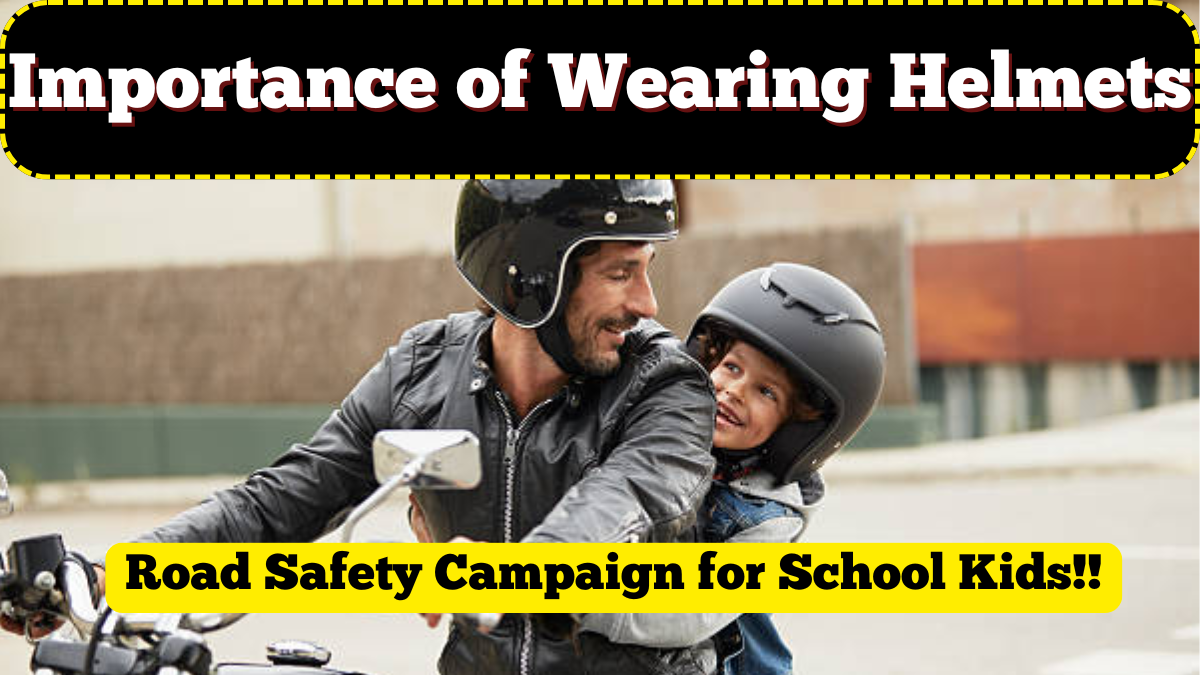Helmet safety is one of the most important, yet most ignored aspects of child road safety in India. With rising numbers of school-going children riding pillion on two-wheelers or cycling to school independently, road safety tips must now include clear and repeated education on the need for proper head protection. The 2025 road safety campaigns across schools are placing a stronger focus on enforcing helmet rules—not just for compliance, but to save young lives.
While adults are more aware of helmet use, many children are still commuting without one—either due to discomfort, lack of awareness, or carelessness. This article explains why helmet safety is critical, the new regulations in place, and how schools and parents can work together to build a helmet-wearing culture.

Why Helmet Safety is Vital for School Children
In India, over 10,000 children are involved in road accidents every year—many of them while on two-wheelers. Here’s why wearing helmets is now an essential part of road safety tips in schools:
-
Children are more vulnerable: Their skulls are still developing, and even minor head trauma can be fatal.
-
Two-wheeler accidents are on the rise: Increased traffic and poor road conditions make children riding or riding pillion extremely unsafe without protection.
-
Head injuries are the leading cause of death in road accidents involving minors.
-
Studies show helmets reduce risk of fatal head injury by over 70% when worn properly.
Wearing helmets, therefore, is not just a precaution—it is a necessity that must be taught and reinforced.
What the 2025 Helmet Safety Rule Says
The Indian government has updated the helmet rule effective July 2025, specifically targeting student safety:
-
All children above age 4 must wear ISI-marked helmets while riding or sitting pillion on two-wheelers.
-
School staff on duty using motorcycles or scooters must wear helmets.
-
Parents can now be fined up to ₹2,000 if their child is found without a helmet.
-
Schools must conduct helmet awareness drives and coordinate with RTOs for inspections.
-
Repeat offenders may face driving license suspensions or mandatory road safety training.
These rules have made helmets an enforceable component of school-level India transport safety practices.
How Schools Can Promote Helmet Awareness
Schools are now playing a central role in building a safety culture around helmet use. Here’s how they can help:
-
Organize Road Safety Weeks with demos, poster-making, and quizzes on helmet usage.
-
Reward students who consistently wear helmets with appreciation certificates or badges.
-
Tie up with helmet manufacturers to distribute affordable ISI-marked helmets in bulk.
-
Educate school bus and two-wheeler staff to be role models for students.
-
Involve traffic police for real-life interaction and field sessions.
Promoting these road safety tips at the school level helps build habits early and sets children up for lifelong safe behavior.
Role of Parents in Enforcing Helmet Use
Parents must take shared responsibility and ensure:
-
Their child always wears a helmet—no exceptions, no excuses.
-
Helmets are ISI-certified, well-fitted, and worn properly with straps secured.
-
They lead by example—children copy what they see.
-
They talk about the importance of helmets not as a rule, but as a safety habit.
Teaching children the why behind helmet use is key to internalizing the practice.
Types of Helmets Suitable for Kids
| Helmet Type | Recommended For | Features to Look For |
|---|---|---|
| Bicycle Helmets | Kids riding cycles to school | Lightweight, air vents, adjustable straps |
| Two-Wheeler Pillion Helmets | Riding with parents on scooters or bikes | ISI-certified, inner padding, chin strap |
| Full-Face Helmets | Older students riding own vehicles | Maximum protection, anti-fog visor |
| Cartoon-Printed Helmets | Younger kids to encourage usage | Colourful designs, safety-compliant |
Schools can help parents choose the right helmets during safety workshops.
FAQs
Is it compulsory for school children to wear helmets in India in 2025?
Yes, under the updated road safety tips and helmet law, all children above age 4 must wear helmets while riding or sitting on two-wheelers.
What happens if my child is found without a helmet?
Parents may be fined up to ₹2,000, and in some cases, may also face license penalties under the new 2025 rule.
Are bicycle helmets enough for two-wheelers?
No. Bicycle helmets are designed for light impacts. Two-wheeler riders must use ISI-marked helmets specifically made for motorbike use.
How can schools encourage helmet safety?
By conducting awareness drives, setting examples through staff behavior, and recognizing students who consistently follow road safety tips.
What kind of helmet should I buy for my child?
Choose an ISI-certified helmet that fits snugly, has a secure strap, and is comfortable enough for daily use. Avoid loose or decorative-only helmets.
Click here to know more.
